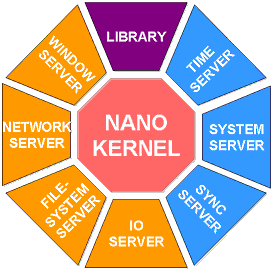 |
Life with dooroos |
|
|
|
|
|
|
 |
dooroos.RealTime™ |
|
 |
| |
 |
INTRODUCTION | |
| |
 |
OVERVIEW |
|
The dooroos.RealTime™ is a real-time, preemptive, multitasking kernel designed
for time-critical embedded applications.
|
|
The dooroos.RealTime™ is a multi-layered, modular, high-performance real-time operating system
designed specifically for embedded microprocessors.
It provides a complete multitasking environment based on open system standards.
It is built around the dooroos.RealTime multi-tasking nano-kernel and
a collection of companion software components and service servers.
Every servers implement a logical collection of system services.
To the application developer, the system service requests appear
as re-entrant C functions callable from an application.
Any combination of server and library components can be incorporated into a system
to match your real-time design requirements.
|
|
The dooroos.RealTime™ can reduce the cost and shorten the developement time of customer target system.
|
 |
ADVANTAGES |
 |
small memory requirement. |
 |
Real-time function. |
 |
Simple development environment. |
 |
High modular architecture. |
 |
Layered arhitecture. |
 |
No initial license charge. |
 |
dooroos.RealTime KERNEL |
 |
|
The dooroos.RealTime eliminates the need for processor allocation in the application software.
When a more important task requires execution, dooroos.RealTime suspends the currently executing task and starts
the higher-priority task. After the higher-priority task finishes,
the suspended task is resumed. The worst-case task response time
under dooroos.RealTime is the amount of time required to suspend the executing task and
resume the more important task. The dooroos.RealTime provides quick and constant response time.
Because of this, modifications, and even additions of completely new tasks can be made
without affecting critical system response requirements. Beside managing task execution,
dooroos.RealTime also provides facilities that include task communications, task synchronization,
timers and memory management.
|
|
From the software development standpoint, dooroos.RealTime fosters less task interdependence and
greater modularity. Because of this, multiple engineers may work on tasks without worrying
about the side-effects present in non-dooroos.RealTime applications. The dooroos.RealTime also provides
a runtime environment that is completely independent of the target processor.
This benefits the development effort in two ways: First, engineers may concentrate on
the real-time application instead of the intricacies of the underlying processor,
Second, engineers may develop applications that execute on most popular microprocessors.
|
|
To summarize, dooroos.RealTime greatly enhances the development of real-time applications.
This translates into lower development costs and shorter development time.
Since dooroos.RealTime allows easy migration of applications to new processor families,
the application development investment is protected.
|
 |
FEATURES |
 |
MULTI-LAYER KERNEL STRUCTURE |
 |
MODULARITY: modularity
|
 |
PORTABILITY: portability
|
 |
SCALABILITY:scalability
|
 |
MULTI_TASK/THREAD |
 |
support multi-tasking and multi-thread.
|
 |
FLEXIBLE IPC |
 |
support flexible IPC.
|
 |
PRECISE TIMER AND PRIORITY BASED REAL-TIME SCHEDULER |
 |
support precise timer.
|
 |
suppport priority base-schedular, preemptive shedular and roundrobin schedular.
|
 |
SCALABLE HARD REAL-TIME |
 |
support the design of hard realtime function.
|
 |
CONSISTANT DEVICE MANAGEMENT & EFFICIENT I/O SERVER SYSTEM |
 |
support constant device management.
|
 |
efficient I/O system.
|
 |
COST EFFICIENT USE OF MEMORY |
 |
very efficient use of memory.
|
 |
support the relocation of kernel modules and etc.
|
 |
RELIABLE & ROBUST SERVICE |
 |
support reliable and robust service.
|
 |
EASY TO USE |
 |
easy to use the kernel system.
|
 |
LOW LATENCY |
 |
support the low latency.
|
|
|
|